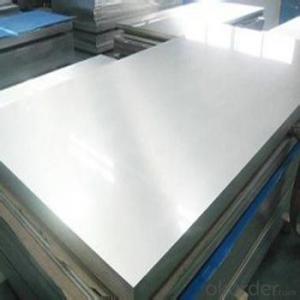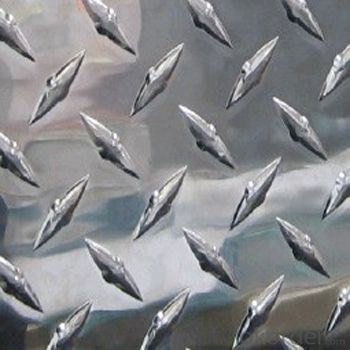Pro Bond Embossed Aluminum Sheet Plate Mill Finish
- Loading Port:
- Shanghai
- Payment Terms:
- TT OR LC
- Min Order Qty:
- 3 m.t.
- Supply Capability:
- 300 m.t./month
OKorder Service Pledge
OKorder Financial Service
You Might Also Like
Specification
Description
Corrosion resistance can be excellent due to a thin surface layer of aluminium oxide that forms when the metal is exposed to air, effectively preventing further oxidation.The strongest aluminium alloys are less corrosion resistant due to galvanic reactions with alloyed copper.This corrosion resistance is also often greatly reduced by aqueous salts, particularly in the presence of dissimilar metals.
2. Specification
EMBOSSED ALUMINIUM SHEET EMBOSSED ALUMINIUM SHEETS ALUMINIUM SHEETS
ALLOY : AA1***(AA1050,AA1060,AA1070,AA1100etc)
AA3***(AA3003,AA3004,AA3005,AA3105etc)
AA5***(AA5052 etc)
TEMPER:H14,H18,H24,H26,H32
THICKNESS:0.2mm-20mm
WIDTH:10mm-1500mm
EMBOSSED PATTERNS : Diamond, stucoo,bars etc
STANDARD: GB/T3880-2006
Special specification is available on customer's requirement
3.Advantage
Best price!
4.Pictures


5.FAQ
1)How about our payment term?
LC and TT and other.
2)Which country can we supply?
All around the world!
- Q: How does aluminum sheet perform in high-pressure applications?
- Aluminum sheet performs exceptionally well in high-pressure applications due to its inherent properties. The strength-to-weight ratio of aluminum is impressive, making it a suitable choice for withstanding high-pressure environments. Additionally, aluminum has excellent corrosion resistance, which is crucial when dealing with high-pressure conditions that may involve exposure to moisture or aggressive chemicals. Furthermore, aluminum sheet is highly malleable, allowing it to be fabricated into various shapes and forms to meet the specific requirements of high-pressure applications. Its flexibility also enables it to withstand the forces and stresses exerted during high-pressure processes without compromising its structural integrity. Moreover, aluminum has good thermal conductivity, which aids in dissipating heat generated by high-pressure systems. This feature helps prevent overheating and ensures efficient operation. However, it is important to note that the performance of aluminum sheet in high-pressure applications can be influenced by factors such as the thickness and alloy composition of the sheet. Therefore, it is crucial to select the appropriate grade and thickness of aluminum sheet based on the specific requirements and operating conditions of the high-pressure application. Overall, aluminum sheet is a reliable and effective choice for high-pressure applications due to its strength, corrosion resistance, malleability, thermal conductivity, and overall performance under demanding conditions.
- Q: Should I purchase a camper made out of aluminum/wood or a fiberglass?I'm looking to purchase a small camper, approx 18', to tow on the back of my SUV. It's a 2011 Wildwood camper. However, I hear campers made out of aluminum and wood aren't very good because the wood can ruin in time and the aluminum can rust, etc. I hear fiberglass campers are better? Anyone have any knowledge or experience with this? Also, any thoughts or advice with brands/models? And about the Wildwood? Thanks in advance.
- Aluminum is lighter so it offers economies over the life of the trailer. The Airstream has been built almost as long as I've been around. It is true that the wood does rot And some care is needed to stop the occasional leak. Fiberglass is heaver and has it's own maintenance issues. I've no experience with the Wildwood. What I do know is that motor homes are dirt cheap right now. You might think about taking advantage of the economy and pick-up a motor home at a bargain.
- Q: i want to build a smelter to recycle aluminum auto parts
- It requires high temperature (933K), and is inefficient for small quantities. Why not just sell it to your local recycler?
- Q: Can aluminum sheets be used for interior design purposes?
- Yes, aluminum sheets can be used for interior design purposes. They are versatile, lightweight, and durable materials that can be used for various applications such as wall cladding, ceilings, countertops, backsplashes, and decorative accents. Aluminum sheets offer a modern and sleek aesthetic, and their availability in different finishes and colors allows for customization to fit various design styles and preferences.
- Q: What kind of aluminum sheet can be bent with five millimeters?
- Depending on the material, alloy and condition you need, except for the bending performance, the thickness is 5mm, there is no other requirement, and the products that China can meet this requirement are everywhere.
- Q: I have seen some stainless steel rifles that you can basically dunk in water, require no cleaning, etc and perform time after time. If SS is so good why are most weapons made of aluminum parts which is then anodized coated black? If you dunk these weapons in water will they rust? Thanks
- Their is no such thing as a corrosion proof metal. It's just corrosion resistant. Some more than others. And regardless it's going to have to be cleaned. When it comes to parts being made out of aluminum instead of steel it boils down to basically weight. Weight saving is a big thing nowadays and while aluminum is up to 5X more expensive its also 3x lighter. Also most aluminum parts on firearms are either low or no stress. Any high stress parts such as the bolt, chamber and barrel has to be made from a steel. No getting around it as aluminum wears out from those types of stresses faster.
- Q: This question asks for the duration aluminum sheets can last and how their lifespan compares to other materials.
- <p>The lifespan of aluminum sheets can vary depending on the environment and usage, but generally, they can last for several decades with proper care and maintenance. Aluminum's resistance to corrosion and weathering makes it a durable choice. Compared to other materials, aluminum is more durable than wood and many plastics, but it may not last as long as some high-quality stainless steels or certain types of stone. It's also lighter than steel, making it a popular choice for construction and manufacturing applications where weight is a concern.</p>
- Q: Can 101 aluminum sheets be anodized in different colors?
- Yes, 101 aluminum sheets can be anodized in different colors. Anodizing is a process that involves creating an oxide layer on the surface of aluminum, which can be dyed to achieve various colors. The number of sheets, in this case 101, does not restrict the ability to anodize them in different colors. Each sheet can be individually anodized and dyed to create a unique and desired color. Anodizing is a versatile process that allows for customization and color variation, making it possible to achieve different shades and hues on each aluminum sheet.
- Q: Are 101 aluminum sheets suitable for solar panel frames?
- Yes, 101 aluminum sheets are suitable for solar panel frames. 101 aluminum is a commonly used grade of aluminum that is known for its excellent strength and corrosion resistance. These properties make it an ideal material for constructing frames that can withstand the outdoor elements and provide adequate support for solar panels. Additionally, 101 aluminum sheets are lightweight, which is important for easy installation and transportation of solar panels. Overall, 101 aluminum sheets are a suitable choice for solar panel frames due to their strength, corrosion resistance, and lightweight properties.
- Q: Can aluminum sheets be used for elevator interiors?
- Yes, aluminum sheets can be used for elevator interiors. Aluminum is a popular material choice for elevator interiors due to its various advantageous properties. It is lightweight, durable, and resistant to corrosion, making it suitable for long-term use in elevator applications. Aluminum sheets can be easily fabricated and shaped to fit the dimensions and design requirements of elevator interiors. Additionally, aluminum can be finished with different types of coatings or finishes, such as anodizing or powder coating, to enhance its appearance and provide additional protection. Overall, aluminum sheets are a viable option for elevator interiors and are commonly used in the industry.
Send your message to us
Pro Bond Embossed Aluminum Sheet Plate Mill Finish
- Loading Port:
- Shanghai
- Payment Terms:
- TT OR LC
- Min Order Qty:
- 3 m.t.
- Supply Capability:
- 300 m.t./month
OKorder Service Pledge
OKorder Financial Service
Similar products
Hot products
Hot Searches
Related keywords


























